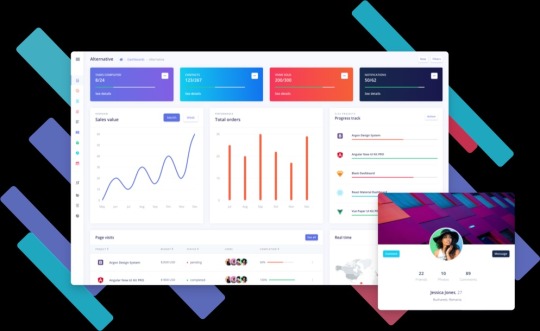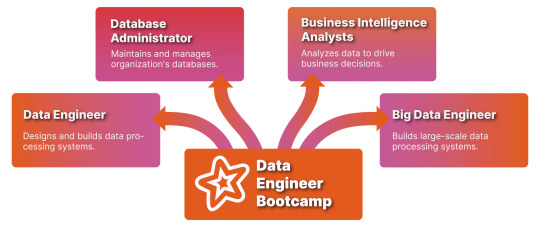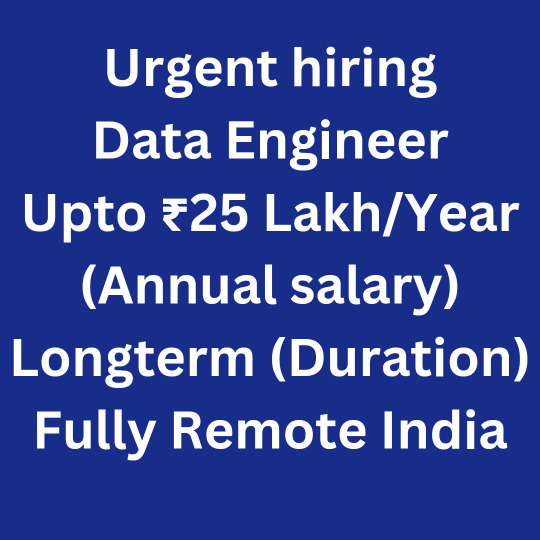#Data Engineers
Explore tagged Tumblr posts
Text

2 notes
·
View notes
Text
Wen it comes to ProcureTech development and implementation what are the roles of Software and D&A Leaders?
0 notes
Text
7 Figure Product Business From Scratch Using A.I Agents
7 Figure Product Business From Scratch Using A.I Agents 7 Figure Product Business From Scratch Using A.I AgentsSIGN UP HERE – https://clientme.aihttps://i3.ytimg.com/vi/No1IbgUkRbA/hqdefault.jpghttps://www.youtube.com/watch?v=No1IbgUkRbA https://igrowsalons.weebly.com/i-grow-salons/7-figure-product-business-from-scratch-using-ai-agents
#Big Data#Creative Engineer#Data Engineers#Distributed Systems#Software Development#Software Engineering
0 notes
Text
How Does MLOps Differ from DevOps?
For more details, you can read this blog. Think of DevOps as the manager of a software development factory. They oversee the entire production process, from design and development to testing and deployment, ensuring the factory runs smoothly and efficiently and consistently delivers high-quality software products.
MLOps is a specialized department in this software factory focused on producing machine learning models. MLOps engineers manage the entire lifecycle of these models, from data preparation and model training to deployment and monitoring. They collaborate closely with data scientists and developers to ensure models are built, tested, and deployed in a reliable, scalable, and maintainable manner.
While DevOps ensures the overall software development process is streamlined and efficient, MLOps specifically addresses the unique challenges and requirements of developing and deploying machine learning models. Just as a factory has different departments for producing various products, MLOps is a specialized unit within the larger DevOps ecosystem, ensuring machine learning models are built and deployed with the same rigor and reliability as other software components.
MLOps tools are designed to address the unique challenges of managing machine learning models. They include model versioning, data versioning, model registry, and model serving.
MLOps tools also provide specialized support for popular machine learning frameworks and libraries, such as TensorFlow, PyTorch, and scikit-learn. This can simplify the deployment of models in production for data scientists, as they won’t have to worry about the underlying infrastructure and deployment mechanisms. Additionally, these tools can streamline the entire process within a single platform, eliminating the need for multiple tools and systems for different parts of the workflow.
Therefore, although DevOps and MLOps share conceptual similarities, such as automation and collaboration, they differ in their scope and the tools and techniques they use.
1 note
·
View note
Text
https://www.coursera.org/professional-certificates/data-engineering
1 note
·
View note
Text
Developing a Power BI Dashboard for Acube AI

In today’s data-driven world, businesses require robust tools to convert raw data into actionable insights. Acube AI is at the forefront of this transformation, leveraging advanced analytics and AI to provide comprehensive data solutions. One of their flagship offerings is the Power BI Dashboard, a powerful tool that enables businesses to visualize, analyze, and interpret their data effectively. This article delves into the creation, features, and benefits of a Power BI Dashboard tailored for Acube AI’s website and business needs.
Understanding Acube AI’s Requirements
Acube AI focuses on providing data analytics and AI-driven solutions to various industries. Therefore, the Power BI Dashboard should reflect the diverse needs of its clients while showcasing Acube AI’s capabilities. Key requirements might include:
Data Integration: Combining data from multiple sources.
Real-time Analysis: Providing up-to-the-minute insights.
Customizable Visuals: Tailoring visuals to different business needs.
User Accessibility: Ensuring the dashboard is easy to use and accessible from various devices.
Key Features of the Power BI Dashboard
Data Integration
Seamless Connectivity: The dashboard can integrate data from various sources such as databases, cloud services, and local files. This integration ensures that users can view comprehensive datasets in one place, enhancing data analysis efficiency.
Automated Data Refresh: Implementing automated data refresh cycles ensures that the dashboard always displays the latest information, facilitating real-time decision-making.
Interactive Visuals
Customizable Charts and Graphs: Users can create and customize a wide range of visuals, including bar charts, pie charts, line graphs, and maps. These visuals help in better understanding complex data sets.
Drill-Down Features: Allowing users to drill down into specific data points provides deeper insights and a more detailed analysis.
Real-Time Analysis
Live Data Streams: Incorporating live data streams enables users to monitor data in real time, crucial for operations that require immediate attention.
Alert and Notification System: Setting up alerts for specific data thresholds helps in proactive management and timely decision-making.
User-Friendly Interface
Intuitive Design: An easy-to-navigate interface ensures that users, regardless of their technical proficiency, can effectively use the dashboard.
Responsive Layout: A design that adapts to different screen sizes ensures accessibility on various devices, including desktops, tablets, and smartphones.

Benefits of Using a Power BI Dashboard
Enhanced Decision-Making
Comprehensive Data View: A centralized dashboard provides a holistic view of all business metrics, making it easier to identify trends and make informed decisions.
Predictive Analytics: Leveraging AI, the dashboard can offer predictive insights, helping businesses forecast trends and prepare accordingly.
Efficiency and Productivity
Automated Reporting: Automating the data reporting process saves time and reduces the likelihood of human error, allowing teams to focus on analysis and strategy.
Collaborative Tools: Features that allow for easy sharing and collaboration on reports and dashboards enhance teamwork and streamline workflows.
Scalability
Adaptability: The dashboard can scale with the business, accommodating growing data sets and more complex analytical needs without compromising performance.
Flexible Licensing: Offering various licensing options allows businesses to choose a plan that best fits their size and needs.
Accessibility
Cloud Integration: Cloud-based dashboards provide the flexibility to access data from anywhere, facilitating remote work and global collaboration.
Role-Based Access: Ensuring that sensitive data is only accessible to authorized users enhances security and compliance.
Applications of the Power BI Dashboard
Sales and Marketing
Performance Metrics: Tracking sales performance, customer acquisition costs, and conversion rates helps in optimizing marketing strategies and improving ROI.
Campaign Analysis: Analyzing marketing campaigns in real time allows for quick adjustments and more effective targeting.
Finance
Financial Health Monitoring: Keeping track of key financial indicators such as revenue, expenses, and profit margins provides a clear picture of the company’s financial health.
Budget Forecasting: Using historical data to forecast budgets and plan financial strategies helps in better resource allocation.
Operations
Efficiency Tracking: Monitoring operational efficiency through metrics like production rates, downtime, and inventory levels helps in optimizing processes.
Supply Chain Management: Real-time tracking of supply chain metrics ensures smooth operations and timely delivery of goods.
Why Choose Acube AI for Power BI Solutions?
Acube AI stands out due to its expertise in data analytics and AI. Their team’s proficiency in Power BI ensures that businesses receive high-quality, tailored solutions that meet their unique needs. Key reasons to choose Acube AI include:
Expertise in AI and Data Analytics: Leveraging advanced AI techniques to provide deeper insights.
Tailored Solutions: Customizing dashboards to align with specific business goals and requirements.
Comprehensive Support: Offering ongoing support and training to ensure clients can maximize the value of their dashboards.
Implementing the Power BI Dashboard
Initial Consultation
Understanding Business Needs: A thorough consultation to understand the client’s business objectives, data sources, and specific requirements.
Setting Goals: Defining clear goals and KPIs that the dashboard should achieve.
Data Integration and Preparation
Data Collection: Gathering data from various sources and ensuring it is clean and ready for analysis.
Data Modeling: Structuring the data in a way that makes it easy to analyze and visualize.
Dashboard Design and Development
Prototyping: Creating initial prototypes to ensure the design meets the client’s expectations.
Development: Building the dashboard with interactive visuals and real-time data capabilities.
Testing and Deployment
User Testing: Conducting thorough testing with end-users to ensure functionality and usability.
Deployment: Implementing the dashboard in the client’s environment and providing training for effective use.
Ongoing Support and Optimization
Continuous Monitoring: Regularly monitoring the dashboard’s performance and making necessary adjustments.
User Feedback: Incorporating user feedback to continuously improve the dashboard’s features and usability.
Conclusion
Investing in a Power BI Dashboard from Acube AI can significantly enhance your data analysis capabilities, leading to more informed business decisions and improved performance. By leveraging Acube AI’s expertise, businesses can ensure they have a powerful tool tailored to their specific needs, driving growth and efficiency in today’s competitive market. For more details and to explore how Acube AI can transform your data strategy, visit Acube AI.
#BI Dashboard Solutions#Acube AI#Data Science Expertise#AI Solutions#Data Engineers#Cutting-edge Technology
0 notes
Text
Data Engineering Fueling the Internet of Things (IoT) Revolution
The Internet of Things (IoT) is rapidly transforming our world, with billions of connected devices generating a constant stream of data. But this data deluge is meaningless without the power of data engineering.
Data engineers are the architects behind the scenes, building the infrastructure that collects, processes, and analyzes this vast amount of information. According to a recent study by Gartner, by 2025, there will be over 25 billion connected devices generating data. Data engineers are crucial in ensuring this data is usable, enabling businesses to unlock the true potential of IoT.
Here's how data engineering fuels the IoT revolution:
Data Ingestion: Data engineers design pipelines to efficiently collect data from diverse IoT devices, often with varying formats and communication protocols.
Data Storage and Management: They build robust and scalable data storage solutions (cloud-based or on-premise) to handle the ever-growing volume of data.
Data Cleaning and Preprocessing: Raw IoT data can be noisy and incomplete. Data engineers clean and transform the data to ensure its accuracy and usefulness for analysis.
Data Analytics Integration: The prepared data is then integrated with analytics tools, allowing data scientists to extract valuable insights for predictive maintenance, optimizing operations, and developing innovative data-driven products and services.
Data engineering is the backbone of the IoT revolution, transforming raw data into actionable intelligence that fuels smarter cities, efficient industries, and a more connected future.
USDSI® presents a detailed guide on how data engineering effectively handles various challenges posed by huge amount of data generated by IoT along with applications of data engineering in IoT.
So, check out now and grab your copy for a detailed overview.
So, download your copy now and learn the synergy between Data engineering and IoT.
1 note
·
View note
Text

1 note
·
View note
Text

SG Analytics - While ChatGPT is a powerful tool that can be used in data engineering, it cannot replace the expertise of a data engineer. Data engineering requires a deep understanding which ChatGPT cannot replicate.
#Data engineers#ChatGPT Replace Data Engineers#AI data engineer#Chatgpt data engineering#esg services#esg data and analytics
0 notes
Text

#jobs hiring#tech jobs#usa jobs#data engineers#data scientist#indiajobs#full time jobs#remote jobs#remote work
0 notes
Text

Data Engineers is one of the pioneers in data recovery industry in Delhi India & has been providing a wide range of data recovery services & solutions in delhi.
#Data Engineers#Mobile Data#ssd/flash Media storage Recovery in delhi.#Data Recovery Services#Data Recovery Services in Delhi#Mobile Data Recovery services in delhi
0 notes
Text
Reverse engineers bust sleazy gig work platform

If you'd like an essay-formatted version of this post to read or share, here's a link to it on pluralistic.net, my surveillance-free, ad-free, tracker-free blog:
https://pluralistic.net/2024/11/23/hack-the-class-war/#robo-boss

A COMPUTER CAN NEVER BE HELD ACCOUNTABLE
THEREFORE A COMPUTER MUST NEVER MAKE A MANAGEMENT DECISION
Supposedly, these lines were included in a 1979 internal presentation at IBM; screenshots of them routinely go viral:
https://twitter.com/SwiftOnSecurity/status/1385565737167724545?lang=en
The reason for their newfound popularity is obvious: the rise and rise of algorithmic management tools, in which your boss is an app. That IBM slide is right: turning an app into your boss allows your actual boss to create an "accountability sink" in which there is no obvious way to blame a human or even a company for your maltreatment:
https://profilebooks.com/work/the-unaccountability-machine/
App-based management-by-bossware treats the bug identified by the unknown author of that IBM slide into a feature. When an app is your boss, it can force you to scab:
https://pluralistic.net/2023/07/30/computer-says-scab/#instawork
Or it can steal your wages:
https://pluralistic.net/2023/04/12/algorithmic-wage-discrimination/#fishers-of-men
But tech giveth and tech taketh away. Digital technology is infinitely flexible: the program that spies on you can be defeated by another program that defeats spying. Every time your algorithmic boss hacks you, you can hack your boss back:
https://pluralistic.net/2022/12/02/not-what-it-does/#who-it-does-it-to
Technologists and labor organizers need one another. Even the most precarious and abused workers can team up with hackers to disenshittify their robo-bosses:
https://pluralistic.net/2021/07/08/tuyul-apps/#gojek
For every abuse technology brings to the workplace, there is a liberating use of technology that workers unleash by seizing the means of computation:
https://pluralistic.net/2024/01/13/solidarity-forever/#tech-unions
One tech-savvy group on the cutting edge of dismantling the Torment Nexus is Algorithms Exposed, a tiny, scrappy group of EU hacker/academics who recruit volunteers to reverse engineer and modify the algorithms that rule our lives as workers and as customers:
https://pluralistic.net/2022/12/10/e2e/#the-censors-pen
Algorithms Exposed have an admirable supply of seemingly boundless energy. Every time I check in with them, I learn that they've spun out yet another special-purpose subgroup. Today, I learned about Reversing Works, a hacking team that reverse engineers gig work apps, revealing corporate wrongdoing that leads to multimillion euro fines for especially sleazy companies.
One such company is Foodinho, an Italian subsidiary of the Spanish food delivery company Glovo. Foodinho/Glovo has been in the crosshairs of Italian labor enforcers since before the pandemic, racking up millions in fines – first for failing to file the proper privacy paperwork disclosing the nature of the data processing in the app that Foodinho riders use to book jobs. Then, after the Italian data commission investigated Foodinho, the company attracted new, much larger fines for its out-of-control surveillance conduct.
As all of this was underway, Reversing Works was conducting its own research into Glovo/Foodinho's app, running it on a simulated Android handset inside a PC so they could peer into app's data collection and processing. They discovered a nightmarish world of pervasive, illegal worker surveillance, and published their findings a year ago in November, 2023:
https://www.etui.org/sites/default/files/2023-10/Exercising%20workers%20rights%20in%20algorithmic%20management%20systems_Lessons%20learned%20from%20the%20Glovo-Foodinho%20digital%20labour%20platform%20case_2023.pdf
That report reveals all kinds of extremely illegal behavior. Glovo/Foodinho makes its riders' data accessible across national borders, so Glovo managers outside of Italy can access fine-grained surveillance information and sensitive personal information – a major data protection no-no.
Worse, Glovo's app embeds trackers from a huge number of other tech platforms (for chat, analytics, and more), making it impossible for the company to account for all the ways that its riders' data is collected – again, a requirement under Italian and EU data protection law.
All this data collection continues even when riders have clocked out for the day – its as though your boss followed you home after quitting time and spied on you.
The research also revealed evidence of a secretive worker scoring system that ranked workers based on undisclosed criteria and reserved the best jobs for workers with high scores. This kind of thing is pervasive in algorithmic management, from gig work to Youtube and Tiktok, where performers' videos are routinely suppressed because they crossed some undisclosed line. When an app is your boss, your every paycheck is docked because you violated a policy you're not allowed to know about, because if you knew why your boss was giving you shitty jobs, or refusing to show the video you spent thousands of dollars making to the subscribers who asked to see it, then maybe you could figure out how to keep your boss from detecting your rulebreaking next time.
All this data-collection and processing is bad enough, but what makes it all a thousand times worse is Glovo's data retention policy – they're storing this data on their workers for four years after the worker leaves their employ. That means that mountains of sensitive, potentially ruinous data on gig workers is just lying around, waiting to be stolen by the next hacker that breaks into the company's servers.
Reversing Works's report made quite a splash. A year after its publication, the Italian data protection agency fined Glovo another 5 million euros and ordered them to cut this shit out:
https://reversing.works/posts/2024/11/press-release-reversing.works-investigation-exposes-glovos-data-privacy-violations-marking-a-milestone-for-worker-rights-and-technology-accountability/
As the report points out, Italy is extremely well set up to defend workers' rights from this kind of bossware abuse. Not only do Italian enforcers have all the privacy tools created by the GDPR, the EU's flagship privacy regulation – they also have the benefit of Italy's 1970 Workers' Statute. The Workers Statute is a visionary piece of legislation that protects workers from automated management practices. Combined with later privacy regulation, it gave Italy's data regulators sweeping powers to defend Italian workers, like Glovo's riders.
Italy is also a leader in recognizing gig workers as de facto employees, despite the tissue-thin pretense that adding an app to your employment means that you aren't entitled to any labor protections. In the case of Glovo, the fine-grained surveillance and reputation scoring were deemed proof that Glovo was employer to its riders.
Reversing Works' report is a fascinating read, especially the sections detailing how the researchers recruited a Glovo rider who allowed them to log in to Glovo's platform on their account.
As Reversing Works points out, this bottom-up approach – where apps are subjected to technical analysis – has real potential for labor organizations seeking to protect workers. Their report established multiple grounds on which a union could seek to hold an abusive employer to account.
But this bottom-up approach also holds out the potential for developing direct-action tools that let workers flex their power, by modifying apps, or coordinating their actions to wring concessions out of their bosses.
After all, the whole reason for the gig economy is to slash wage-bills, by transforming workers into contractors, and by eliminating managers in favor of algorithms. This leaves companies extremely vulnerable, because when workers come together to exercise power, their employer can't rely on middle managers to pressure workers, deal with irate customers, or step in to fill the gap themselves:
https://projects.itforchange.net/state-of-big-tech/changing-dynamics-of-labor-and-capital/
Only by seizing the means of computation, workers and organized labor can turn the tables on bossware – both by directly altering the conditions of their employment, and by producing the evidence and tools that regulators can use to force employers to make those alterations permanent.

Image: EFF (modified) https://www.eff.org/files/issues/eu-flag-11_1.png
CC BY 3.0 http://creativecommons.org/licenses/by/3.0/us/
#pluralistic#etui#glovo#foodinho#alogrithms exposed#reverse engineering#platform work directive#eu#data protection#algorithmic management#gdpr#privacy#labor#union busting#tracking exposed#reversing works#adversarial interoperability#comcom#bossware
352 notes
·
View notes
Text
With growing concerns over online privacy and securing personal data, more people than ever are considering alternatives to Google products.
After all, Google's business model essentially revolves around data collection and advertisements, both of which infringe on your privacy. More data means better (more targeted) ads and consequently, more revenue for Google. The company pulled in over $230 billion in ad revenue last year — and that number continues to climb higher.
But the word is getting out. A growing number of people are seeking alternatives to Google products that respect their privacy and data. Since you are reading this, we assume you are one of them.
Small steps to restoring your privacy
When beginning the journey of restoring digital privacy, some people get overwhelmed with all the work involved, and perhaps give up. Don't let that be you. Understand that you don't need to do everything right away. Instead, start small and go step by step at your own pace. With each step in the process, you get more security and control over your personal data, which is a small victory.
So don't be overwhelmed and remember that there's no “one size fits all” with this process. Even small changes, such as using a private search engine and a privacy-focused browser, are victories. So push on in your quest for more privacy and celebrate each step of the journey.
#article#google#de google#google alternatives#fuck google#search engines#email#internet privacy#privacy#data#internte#resource#degoogle
139 notes
·
View notes
Text

HARDWARE!
SOFTWARE!
(x)
#tried to upload this on insta aswell without success#ah well#starlight express#stex#electra the electric engine#morf's art#stex fanart#electra#raw data feel#i guesssssss#traditional art#e_e_
161 notes
·
View notes
Text

"MUSCLE EMPHASIS TABLETS" -
Bloody Wolf (Data East - PC Engine - 1990)
442 notes
·
View notes
Text






reopening my kofi shop! i have some new items and some old ones, im moving soon so im trying to get rid of what i do have in storage LOL. YOU CAN FIND IT HERE!
#my art#kim kitsuragi#harry du bois#jean vicquemare#disco elysium#star trek#spock#james t kirk#spirk#lt commander data#data soong#lore soong#tng#tos#tf2#tf2 engineer
346 notes
·
View notes